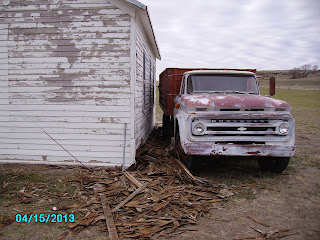But, we have had a few
drops of moisture. The wheat planted
last fall doesn’t look too bad for all it has been through. (Here, an acquaintance pointed out, goes my native
pessimism. “Doesn’t look too bad” is in
the negative. “Looks fair to good” would
be the more positive way of stating the wheat condition.)
The late cold
weather had less of an effect on the wheat here in Eastern Colorado than it did
in Kansas, where the development was farther along. A Goodland, Kansas gardener who writes a
column in the weekly newspaper compared this April with last April. Last year, he had early spring crops,
radishes, peas, growing full tilt. This
year, the soil is so cold that as of the middle of April, nothing had begun to
grow.
But some moisture tagged along with the cold weather. So, time
to finish breaking out the sod. One of
the biggest reasons I am two weeks overdue is in a way related to weather. We had a barbershop program planned for March
23. It snowed out, blizzarded so bad
that I 70 was closed.
We rescheduled
for May 4, which meant we had to continue practicing. Then, we had another program to do in Sharon Springs
on Sunday April 21. I took off for
Colorado on Monday April 22 in misty drizzle. I
experienced a great variety of weather on my trip to the farm, from spotty
sunshine and balmy temperatures (the fifties) in Burlington, to the fog and
drizzle I left.
The sunshine gave way to overcast. By the time I reached Genoa, the tops of the
windmills were hidden in cloud. As I reached
the farm, the giants had disappeared entirely.
By Monday evening:

Tuesday looked
like this in the morning:
And like this in the evening:
Note the
nearly-full moon playing at being a mole on the roof’s cheek.
Not the best
farming weather, but very welcome moisture, of course. It was nice enough that I could lay out the
course for another row of bushes north of the yard. The old Ponderosas are losing their lower
branches and don’t provide the wind protection, they used to. Overboots and coveralls separated me from the
unmelted snow, mud, and chilly air.
Wednesday evening
brought another little shower and some weird skies, but the snow was pretty
much gone.
Even Pikes Peak
donned a rarely-used coat for this late spring weather.








































